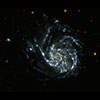Feature Story
Revisiting Classic Stellar "Real Estate" with GALEX
As the most sensitive ultraviolet telescope ever launched, NASA's Galaxy Evolution Explorer (GALEX) scouts galaxies, or "stellar communities," over 10 billion years of cosmic history.
Since its launch in April 2003, GALEX has glimpsed hundreds of thousands of galaxies -- revealing some of the hottest stellar neighborhoods in the cosmos. Here's a look back at some of the mission's most memorable views.
ANDROMEDA, THE GALAXY NEXT DOOR
At approximately 2.5 million light-years away, the Andromeda Galaxy, or M31, is our Milky Way's largest galactic neighbor. The entire galaxy spans 260,000 light-years across -- a distance so large, it took 10 GALEX images stitched together to produce this view of the galaxy next door.
The wisps of blue making up the galaxy's spiral arms are neighborhoods that harbor hot, young, massive stars. Meanwhile, the central orange-white ball reveals a congregation of cooler, old stars that formed long ago.
Andromeda is so bright and close by that it is one of only three galaxies that can be spotted from Earth with the naked eye. This view is two-color composite, where blue represents far-ultraviolet light, and red is near-ultraviolet light.
STRUCTURAL INTEGRITY OF THE PINWHEEL GALAXY
The structural integrity of M101, or the Pinwheel Galaxy, is revealed in this classic image from GALEX.
Unlike our closest large galactic neighbor, the Andromeda galaxy, both young and old stars are evenly distributed along M101's tightly wound spiral arms. Blue shows the presence of hot, young stars that formed about 10 million years ago, and regions that glow yellow harbor older, cooler stars that are over 100-million years old.
M101 stretches twice the diameter of our Milky Way galaxy, and is located approximately 27 million light-years away in the constellation Ursa Major.
This image of the Pinwheel Galaxy is a two-color composite, where far-ultraviolet light is blue, and near-ultraviolet light is red.





